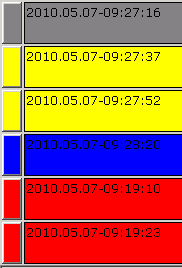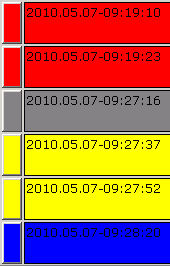User manual

Naming of user interface
Event category buttons

Event category buttons correspond to the existence of any non-normal event in its own category. Indicator lamp is blinking if any non-acknowledged event is in the event-queue. It is continuously on if only acknowledged events are in the category queue, and OFF (grey) if there is no any event in its category. Numbers indicate the non-acknowledged/acknowledged events in its own category. Collective acknowledge button allows acknowledging all events in its own category by a single action. Colors correspond to the categories and are reflected throughout the application.
Date/Time and user login

System date and time is synchronized with the server time (server time is gained from that PC on which it is running). It’s not possible to set this time in the application. It should be set through the server OS system date/time tool. Click on the "user" button for user-logout. In the user login window, fill in the new user name and password. User rights are assigned to the different users. User permissions can be set in the application permission menu (mainly by admin rights).
EventView filter and sort

Click on the header of event category buttons, to filter the records of the queue by its categories. Header buttons ON-OFF state indicate if the corresponding category is shown or hidden in the EventView.
| Examples of Sizes | ||
|---|---|---|

|

| |
Using the „ON LINE” button,

Using the „ON LINE” button, you can freeze temporary the incoming events in the EventView. This is useful when mass of events raise in a very same time and the incoming events make difficult to analyze or handle the most important pending events. EventView is unfreezed in 2 minutes automatically without any user interaction.
TIME/CAT button is to sort the EventView. Choosing the „CAT” button the events are sorted by category. While choosing the „TIME” button events are sorted by the time-stamp (when event occurred in the system). In case of a subsystem that uses timestamps in its communication protocol, this time comes from the subsystem (real-time occurrence). Some subsystem doesn’t use timestamp in its protocol. In this case the management system assigns the time information to the events when it was captured.